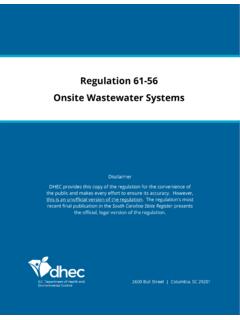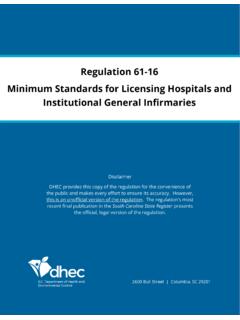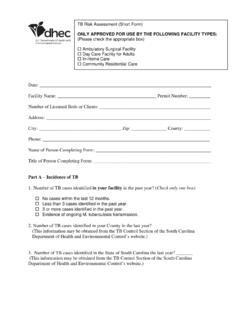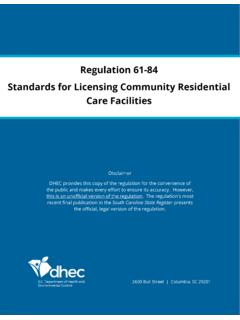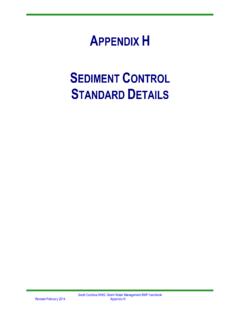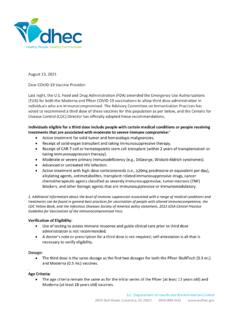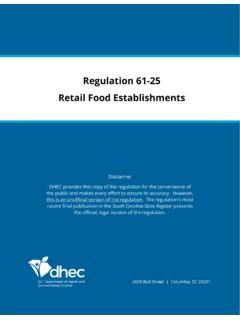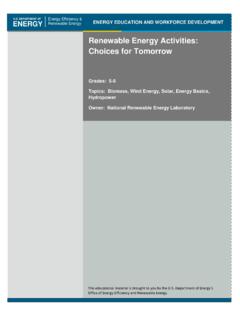Transcription of Natural Resources - SCDHEC
1 Natural ResourcesNatural Resources are materials from the earth that are used to support life and meet people s Natural substance that humans use can be considered a Natural resource . Oil, coal, Natural gas, metals, stone and sand are Natural Resources . Other Natural Resources are air, sunlight, soil and water. Animals, birds, fish and plants are Natural Resources as well. Natural Resources are used to make food, fuel and raw materials for the production of goods. All of the food that people eat comes from plants or animals. Natural Resources such as coal, Natural gas and oil provide heat, light and power. Natural Resources also are the raw materials for making products that we use everyday from our toothbrush and lunch box to our clothes, cars, televisions, computers and and Nonrenewable Resources Renewable Resources are those Natural Resources such as trees, water, sun and wind that can be replenished at about the same rate at which they are used.
2 Renewable Resources , however, can be depleted if not properly managed or Resources are those Natural Resources that are depleted more quickly than they can regenerate. Fossil fuels like oil and Natural gas were formed over millions of years. Once mined and used completely, nonrenewable Resources are gone Challenges of Using Natural ResourcesExtracting, processing and using Natural Resources can cause environmental problems such as: air, land and water pollution; disruption or destruction of ecosystems; and a decrease in example, carbon dioxide which is produced from burning coal, oil and Natural gas (fossil fuels) is a critical greenhouse gas. Greenhouse gases absorb and retain heat from the sun. Examples of greenhouse gases include methane, ammonia, sulfur dioxide and certain chlorinated hydrocarbons.
3 Many scientists believe that the build up of greenhouse gases in the atmosphere can cause global climate change (change in the average global temperature of the atmosphere near the earth s surface). Over time, this condition could pose dangers around the world such as flooding, drought and and using Natural Resources also can disturb relationships within ecosystems. What are ecosystems? Ecosystems, which include ponds, wood lots and fields, are self-regulating communities of plants and animals that interact with each other and their non-living environment. For example, trees cleared from a field can destroy habitats used by many animals, forcing them to find homes elsewhere. If these animals leave the ecosystem, further disturbances can occur within plant and animal populations that depend on these and using Natural Resources along with other human activities may decrease biodiversity that is the variety of organisms that live on the earth .
4 Diminishing the earth s biodiversity has a substantial human cost because Products Made from Natural ResourcesPeople use an abundance of Resources to survive in a continually developing world. Globally, however, some people live simpler lifestyles than others and therefore use fewer Resources . This table lists some Natural Resources and the products and services people produce from ResoURCePRodUCT/seRviCeTreesPaper, furniture, fuelCottonClothingoil/petroleumPlastic, fuelNatural gasFuelCoalFueliron oreSteel products (cans, bridges)Bauxite oreAluminum products (cans, car parts)GoldJewelry, dental materialCopperWire, coins, electrical equipmentManganeseSteel, cast ironCobaltSteel, jet engine parts, cutting toolsPlatinumAir pollution control and telecom-munications equipment, jewelryChromiumStainless steel, green glass, leather treatmentdiamondsJewelry, mechanical equipmentsoURCe: The Quest for Less.
5 A Teacher s Guide to Reducing, Reusing and Recycling, 2005 edition, of Solid Waste Reduction & Recycling1-800-768-7348 l s Office of Solid Waste Reduction and Recycling FYIs provide general information on environmental topics. Readers are encouraged to reproduce this material. For more information about solid waste issues, please call 1-800-768-7348 or visit our Web site at Please send written correspondence to: DHEC s Office of Solid Waste Reduction and Recycling, 2600 Bull Street, Columbia, SC on Recycled Paper OR-0689 3/08wild species and Natural ecosystems are important Resources . Some economists, for example, estimate that the lost pharmaceutical value from plant species extinctions in the United States is about $12 billion. resource Recovery Natural Resources used for the first time are considered virgin Resources and their extraction, processing and use require a great deal of energy and can create recovery is a practice that conserves Natural Resources by extracting material ( , paper, glass, aluminum and steel) from the waste stream and recycling it into other materials or using it to produce energy.
6 More and more companies are developing new and innovative technologies that use recycled materials in the manufacturing of products. Many steel mills, for example, use a manufacturing process that uses virtually 100 percent recovered steel as the raw s another example. A company can create plastic from oil, a virgin Natural resource , or it can use recovered plastic from recycling programs. If a company uses recovered plastic, it is recycling material that would otherwise become waste, helping prevent the depletion of Natural Resources , conserving energy and preventing pollution that would have been created in the extraction and processing of oil from the can you help?There are many ways each of us can conserve Natural Resources . Reducing our consumption that is reducing what we buy, buying products with less packaging, reusing what we can, composting and recycling is one of the easiest for part of this For Your Information (FYI) fact sheet was provided by The Quest for Less: A Teacher s Guide to Reducing, Reusing and Recycling, 2005 edition, Environmental Protection Agency ( EPA).
7 Natural Resources in south CarolinaResource Recovery in actionl Recycling or reuse of 2,000 pounds of paper saves 7,000 gallons of water and 380 gallons of oil. l Using recovered aluminum cans saves 95 percent of the energy required to make the same amount of aluminum from bauxite ore its virgin source. l Recovered steel is the industry s single largest source of raw materials. In 2005, more than 75 percent of the steel produced in the United States was made from recovered steel. l For every ton of recovered glass (cullet) used to make new glass, more than 2,000 pounds of raw materials are saved including 1,300 pounds of sand, 410 pounds of soda ash, 380 pounds of limestone and 160 pounds of feldspar. Using recovered glass also saves energy and reduces greenhouse gas : American Forest and Paper Association; Aluminum Association; Steel Recycling Institute; and Glass Packaging a renewable resource cover almost two-thirds of South Carolina s land area and are used to produce lumber and pulpwood for paper production.
8 The state has large deposits of kaolin (a type of clay) as well as peat, sand, limestone and gravel. Granite is mined throughout the state for crushed stone used in construction or dimension stone used in monuments including the World War II Memorial in Washington, South Carolina is the nation s leading producer of vermiculite, which is used for insulation and as a medium for planting. In addition, there is a limited amount of gold mining in the state. South Carolina has no known economic deposits of mineral fuels such as coal or Natural gas.
